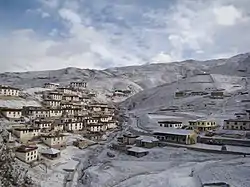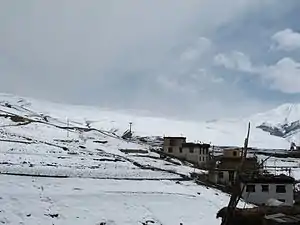Kibber
Kibber also Kyibar is a village high in the Spiti Valley in the Himalayas at 4270 metres or 14,200 ft in Himachal Pradesh in northern India. It contains a monastery and the Kibber Wildlife Sanctuary. It is located 20 kilometres from Kaza and a bus service connects them in the milder summer months. Agriculture forms the backbone of the local economy and lush green fields are abundant.[1]
Kibber | |
|---|---|
Village | |
 Kibber village in winter | |
 Kibber Location in Himachal Pradesh, India  Kibber Kibber (India) | |
| Coordinates: 32.331667°N 78.008889°E | |
| Country | |
| State | Himachal Pradesh |
| District | Lahul and Spiti |
| Elevation | 4,270 m (14,010 ft) |
| Population (2011) | |
| • Total | 366 |
| Languages | |
| • Official | Hindi and the indigenous languages of the Ladakhi peoples of Indo-Aryan and Tibetan descent. |
| Time zone | UTC+5:30 (IST) |
| Vehicle registration | HP- |
| Climate | Dfc |

Transport and ALG
Kibber is being considered as an List of ALGs of IAF. It was surveyed, but as of January 2021 no progress has been made.[2] It will be closest ALG to Chumar, Kaurik, and Tashigang-Shipki La disputed area on India China Border.[2]
Demographics
Kibber Khas is a small village located in Spiti of Lahul and Spiti district, Himachal Pradesh with total 77 families residing. The Kibber Khas village has population of 366 of which 187 are males while 179 are females as per Population Census 2011.
In Kibber Khas village population of children with age 0-6 is 36 which makes up 9.84% of total population of village. Average Sex Ratio of Kibber Khas village is 957 which is lower than Himachal Pradesh state average of 972. Child Sex Ratio for the Kibber Khas as per census is 565, lower than Himachal Pradesh average of 909. Kibber Khas village has lower literacy rate compared to Himachal Pradesh. In 2011, literacy rate of Kibber Khas village was 72.73% compared to 82.80% of Himachal Pradesh. In Kibber Khas Male literacy stands at 82.93% while female literacy rate was 62.65%.[3]
Kibber Wildlife Sanctuary

The Kibber Wildlife Sanctuary was established in 1992, which spans over an area of 2,220.12 km2 of land.[4] The elevation range of this sanctuary is 3,600-6,700 m above mean sea level. The vegetation here is sparse and have high medicinal properties. This sanctuary has been extensively surveyed by C.P. Kala for distribution of plants and their indigenous uses as established by the amchis - the practitioners of Tibetan medical systems. Eight rare and endangered medicinal plant species have been discovered by C.P. Kala from this sanctuary. Aconitum rotundifolium, Arnebia euchroma, Ephedra gerardiana, Gentiana kurroo and Dactylorhiza hatagirea are such threatened but medicinally important plants occur in this sanctuary.[5][6]
Up to 30 snow leopard has been found by wildlife wing of forest department of Himachal Pradesh.[7][8]
See also
- Military bases
- List of ALGs
- List of Indian Air Force stations
- India-China military deployment on LAC
- List of disputed India-China areas
- Tianwendian
- Ukdungle
- Borders
- Actual Ground Position Line (AGPL)
- India–Pakistan International Border (IB)
- Line of Control (LoC)
- Line of Actual Control (LAC)
- Sir Creek (SC)
- Borders of China
- Borders of India
- Conflicts
- Kashmir conflict
- Siachen conflict
- Sino-Indian conflict
- List of disputed territories of China
- List of disputed territories of India
- List of disputed territories of Pakistan
- Northern Areas
- Trans-Karakoram Tract
- Operations
- Operation Meghdoot, by India
- Operation Rajiv, by India
- Operation Safed Sagar, by India
- Other related topics
- India-China Border Roads
- List of extreme points of India
- Sino-Pakistan Agreement for transfer of Trans-Karakoram Tract to China
- Defence Institute of High Altitude Research
- Indian Astronomical Observatory
References
- "The Tibetan Buddhist Monasteries of the Spiti Valley".
- Himachal Pradesh: Demand for airstrip in Spiti area, TImes of India, 17 July 2020.
- "India 2011 census". Retrieved 7 September 2015.
- http://hpforest.nic.in/files/KibberWildLifeSanctuary_A1b.pdf
- Kala, C.P. 2005. Indigenous uses, population density, and conservation of threatened medicinal plants in protected areas of Indian Himalayas. Conservation Biology, 19 (2): 368-378.
- Kala, C.P. 2005. Health tradition of Buddhist community, and role of amchis in trans-Himalayan region of India. Current Science, 89 (8): 1331-1338.
- "Up to 30 snow leopards in Kibber wildlife sanctuary of Spiti". Times of India.
- "Spiti Snow leopard trail". Raacho Trekkers.